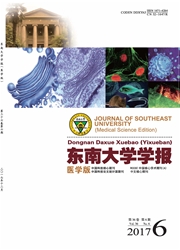

 中文摘要:
中文摘要:
目的:探讨纳米氧化铝颗粒对大鼠肾脏的潜在毒性作用。方法:将75只雌性SD大鼠随机分为对照组、非纳米氧化铝(nNAOs)组(50 mg.kg-1)、纳米氧化铝(NAOs)组(50 mg.kg-1),每组25只,每2 d腹腔注射1次,共60 d。采用原子吸收分光光度法分别在第2、4、8、15、30天测定铝元素在肾组织中的含量,注射60 d后,全自动生化仪测定大鼠血清生化指标,免疫组化染色观察肾组织中巢蛋白表达水平。结果:NAOs组大鼠肾组织中铝元素的浓度在染毒第2天后即显著升高,第15天达到峰值后逐渐降低。而nNAOs组铝元素的含量随染毒时间延长而逐渐升高,在第30天达到高峰;与对照组相比,NAOs组可引起血清尿酸(UA)升高(P〈0.05),而nNAOs组可引起肌酐(Cr)升高(P〈0.05);3组大鼠肾小球中均可见巢蛋白表达,阳性细胞胞体形态及数目未见显著差异。结论:纳米氧化铝与非纳米氧化铝在大鼠肾脏中排泄特征不同,分别引起血清不同指标的异常升高,但在免疫组化切片中未见肾小球组织器质性损害。
 英文摘要:
英文摘要:
Objective: To determine the toxic effects of nano-scale aluminum oxide(NAOs) on kidney in rats.Methods: SD male rats were randomly divided into 3 groups: control group,non nano-scale aluminum oxide(nNAOs) group and NAOs group.Each group was treated by intraperitoneal injection once two days.The accumulation and metabolism of Al was analyzed by atomic absorption spectrum(AAS),expression of nestin was analyzed by immunohistochemistry.After 60 days the rats were sacrificed and the serum were collected for biochemical analysis.Results: The accumulation and metabolism of NAOs and nNAOs in rat kidneys were different.Compared with control group,the concentration of serum UA in NAOs group and the serum Cr in nNAOs group were significant higher.There is no different expression of nestin in the three groups.Conclusion: NAOs may induce the damage to the kidneys in rats,which maybe related to the special particle and metabolism characters.
 同期刊论文项目
同期刊论文项目
 同项目期刊论文
同项目期刊论文
 期刊信息
期刊信息
